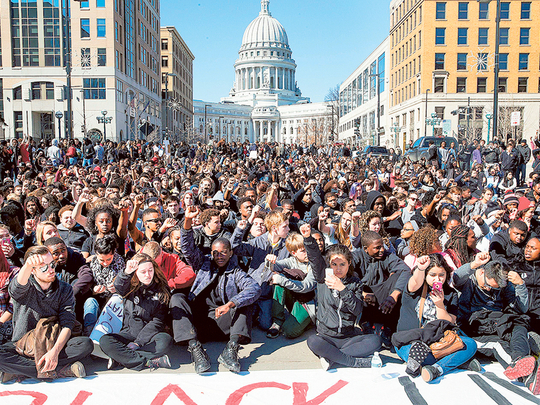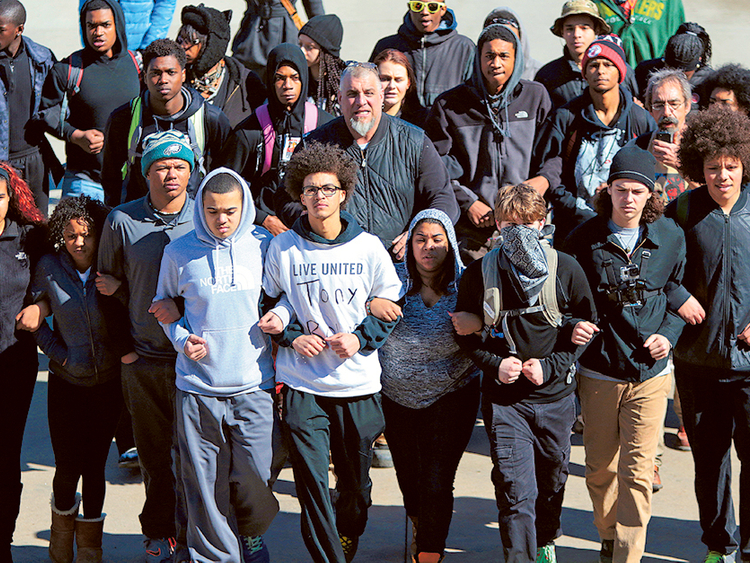
Madison, Wisconsin: Known as a liberal haven with a long history of progressive politics, Madison takes pride in being named one of the nation’s best places to live, raise a family and retire, lovingly embracing its unofficial motto as “77 square miles surrounded by reality.”
But the fatal shooting of an unarmed young biracial man by a white police officer in the heart of one of the city’s most liberal neighbourhoods is forcing a renewed discussion about the racial divide in a community where African-Americans make up 7 per cent of the population but account for a disproportionate share of arrests, incarcerations and children in poverty.
“Madison relies on its progressive history and past to ignore the current realities,” said Sergio Gonzalez, a 27-year-old graduate student at the University of Wisconsin who grew up in Milwaukee. “It’s unfortunate it takes the death of a 19-year-old to open up the eyes of Madison.”
Tony Robinson was shot and killed by police officer Matt Kenny early on Friday evening. Kenny was investigating a call that a young man was jumping in and out of traffic and had assaulted someone. The officer heard a disturbance and forced his way into an apartment where Robinson had gone. Authorities said Kenny fired after Robinson assaulted him.
Reports described Robinson as black based on police descriptions of him as African-American. But at a news conference Monday, family members repeatedly emphasised that he embraced a biracial identity from having a white mother and black father.
Since the shooting, the police chief and mayor — both white — have struck a conciliatory tone with black leaders, who have organised peaceful protests and marches in reaction to the shooting. The police chief apologised for the shooting on Monday without acknowledging any wrongdoing by the officer or the department. An investigation by the state Department of Justice is ongoing.
Those who have worked for years on addressing Madison’s racial disparities hope that the shooting brings new attention to underlying problems in the city of 240,000 that is anchored by the University of Wisconsin campus and the state Capitol.
A 2013 report by Wisconsin Children and Families analysed census data to paint a picture of two Madisons — one where white people were thriving and blacks were struggling.
The report showed that the unemployment rate for blacks in Dane County, which includes Madison, was 25 per cent in 2011 compared with 5 per cent for whites. That was a larger divide than both the state and national average.
Other statistics are even more striking. The percentage of black children living in poverty in Madison was 58 per cent over a three-year period ending in 2013, compared with 5 per cent for white children. Nationally, 38 per cent of black children were in poverty over that time.
Student test scores, juvenile and adult arrests rates, incarceration rates and graduation rates all show massive gaps between whites and blacks.
“This is one of the best places in America, and I love this community. But until we solve some of the issues in this city, we can’t call ourselves progressive,” said Michael Johnson, leader of the Boys and Girls Club of Dane County. “It’s like a cancer. You have to root out the problems causing the economic challenges for the city.”
Jacquelyn Hunt, a mother of seven and grandmother of four who moved to Madison from Chicago 25 years ago, said Madison’s white liberals have convinced themselves there is equity and justice in the city.
“But we’re finding out more and more that’s not the case,” said Hunt, who is African-American. She came to the Capitol on Monday to join high school students who walked out of class to speak out against the shooting.
The message can be a difficult one for a city where President Barack Obama carried 78 per cent of the vote in 2012 and residents pride themselves on their progressive politics.
The shooting occurred on Williamson Street, affectionately known as Willy Street by the locals, just one block from a well-known natural food co-op. Rep. Mark Pocan, an openly gay Democratic congressman, lives just a few blocks away. In a statement, he noted that black men in Madison are arrested at eight times the rate of whites.
“My hope,” said Pocan, who is white, “is that out of this tragedy comes an opportunity for our community to grow stronger together.”
Rhea Vedro, a white woman who carried a sign that said “White Silence = White Consent” to Monday’s rally, said it’s easy for people in Madison to ignore the racial divide.
“There are two or three different Madisons,” Vedro said. “People don’t really mix unless they have to in school.”













